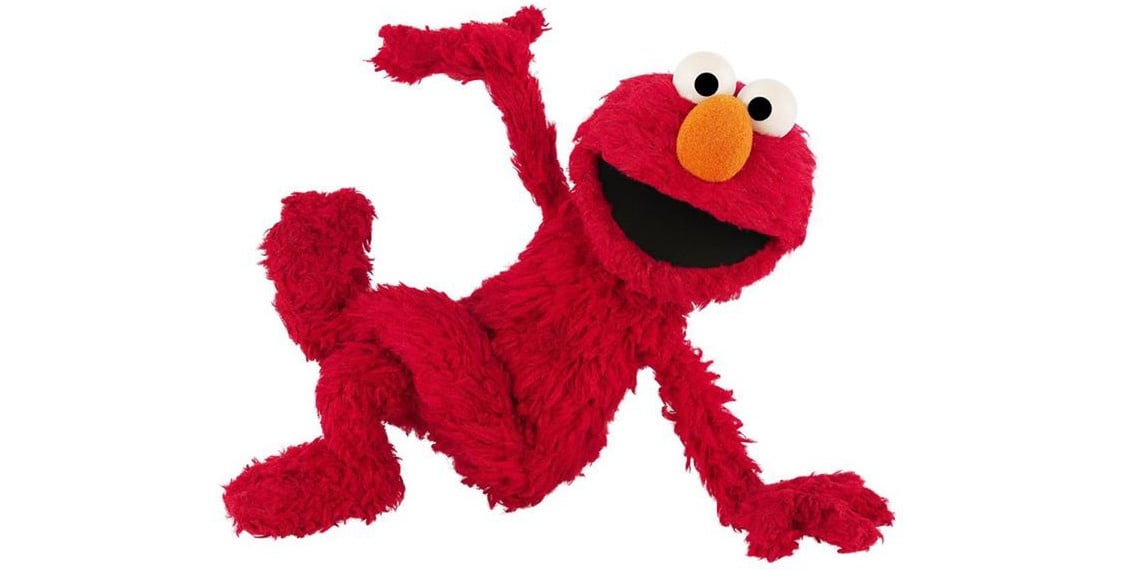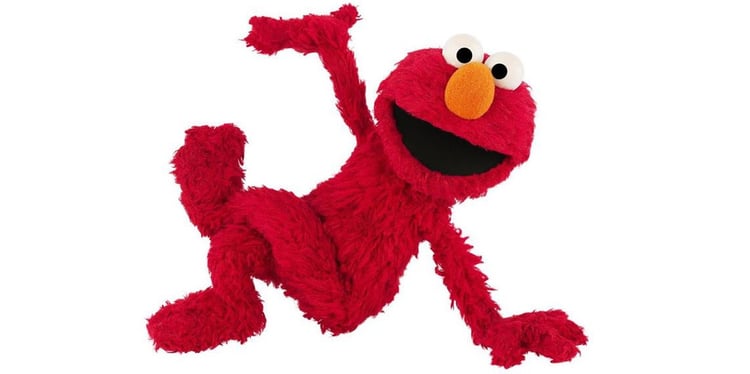

As the father of children aged one and five, my life has been impacted by Elmo. My youngest repeatedly demands the furry red monster by name, starting every morning at breakfast. Her older sister was exactly the same way.
What is it about Elmo?
He’s a bigger deal than Barney the Dinosaur, Dora the Explorer, My Little Pony or even Mickey Mouse. Market Evaluations, a company that ranks the likability of celebrities, has reported that Elmo is by far the most popular character for young children, and as easily recognized by them as Santa Claus.
Elmo is literally Sesame Street’s saviour. In 1996 he rescued the beleaguered show from being bought out by an aggressive, muppet-hungry Disney in the wake of Jim Henson’s death. It happened by way of an unexpected surge in royalties on sales from Tyco Preschool’s Tickle Me Elmo. The must-have toy of the century had parents literally brawling and stampeding in store aisles to bag a giggling Elmo for their kid. To this day, having sold over 10 million units, Tickle Me Elmo remains the world’s biggest holiday toy sensation.
This success has been followed up with a long series of top-selling interactive Elmo toys and thousands of Elmo-branded products, and Sesame Street remains North America’s most popular children’s TV show. In 2015 Sesame Workshop reports taking in almost $65 million in licensing and royalties on Elmo and friends, representing just a fraction of actual retail merchandise sales.
How does a character on a not-for-profit children’s show become such a massive commercial hit? According to Sesame Street lore, Elmo’s popularity is not at all by design. The red muppet first named “Baby Monster” in 1979 remained a background character until 1984. That's when a new, deep-voiced puppeteer named Kevin Clash picked him up, put on the now-famous falsetto and transformed Elmo into the show’s most popular character ever. Apparently it was just that random and unplanned.
But to a marketer, there are some very sound explanations for Elmo’s popularity. As someone who has spent more than two decades thinking about what succeeds (and doesn’t) at my Edmonton web design, branding and inbound marketing agency, I can appreciate the many contributing factors to Elmo’s marketing triumphs. If these are truly coincidental, Elmo is the perfect happy accident, and is regardless worth studying:
1) Elmo is Colour Psychology, Personified
Or should I say monster-ified? According to Bausch and Lomb, the very first colour babies can see as their eyes develop is red. And while although adults tend to feel emotional and even angry when looking at it (hence the phrase “seeing red”), scientific studies have shown the same colour makes young children feel calm, secure and happy. This may help explain why not all parents share their child’s deeply rooted love of Elmo.
2) Elmo Rocks “Effective Frequency”
Of all the characters on Sesame Street, only Elmo refers to himself consistently in the third person. Aside from annoying grammar teachers, this has the effect of causing Elmo’s name to be spoken many more times than that of any other character. In branding we use the term “effective frequency” to describe how many impressions it takes for a brand name to stick in people’s memory: generally between 7 and 20. On a single 15-minute segment of “Elmo’s World,” I counted the lead character’s name being said 36 times. Other principal characters like Big Bird and Cookie Monster might on a good day have their name mentioned five times during the entire show. Elmo doesn’t just push the limits; he revolutionizes them.
3) Elmo is a Smart Brand Name
When we do brand name development, one of the more important criteria is that the name is easy to remember and pronounce by its target audience. Sure, very young children may pronounce Elmo’s name “Ammo”, but it’s nonetheless unmistakable and easier than Barney or SpongeBob SquarePants. And it’s somehow magical: little kids love to say it. Try to come up with a better character name for this audience.
4) Elmo Has Perfect Pitch
Soon after my first daughter was born, I learned how to adjust my voice to capture her attention. I found she would often ignore my normal voice, but was instantly enthralled if I spoke in my highest possible pitch. Elmo’s squeaky voice and drawn-out inflections are the perfect tone and pace for young children. An article at HealthyChildren.org coaches parents to “raise the pitch of your voice, slow your rate of speech, exaggerate certain syllables, and widen your eyes and mouth more than normal.” In other words, just be Elmo.
5) Elmo Uses Jingles
With the theme songs to “Elmo’s World” and “Elmo the Musical,” not to mention the children’s hits “Happy Tapping with Elmo” and “Elmo’s Song,” Elmo has several catchy tunes that centre on his name. In advertising, we call these jingles. It's a famously effective way to persistently occupy a place in the audience’s mind by embedding an ear-worm that carries on subliminally, long after the messaging is delivered.
6) Elmo Always Delivers Payback
Even very young children learn the rhythm and routine of “Elmo’s World,” and eagerly anticipate that when Elmo opens his closet door he’ll be buried under an avalanche of powdery snow, birthday presents or rubber balls. Both my girls laughed heartily at this slapstick from an early age. Willingness to take a bit of a hit to provide your audience with rewarding payback is bold (and smart) marketing.
7) Elmo Reflects His Audience
Mirroring your audience is one of the most effective marketing techniques, and Elmo speaks directly to children, using their own familiar style of imperfect English. He comes across as one of their young friends, never as a puppet animated by a grown-up. He giggles at anything, is thrilled to learn, and is unabashedly silly, just like a three-year-old. If you want your audience to pay attention, drop your industry jargon and demonstrate that you relate to them on their own level.
8) Elmo’s Got Staying Power
Fads come and go, and every season brings new trendsetters. But for more than 30 years, Elmo has been the steady number one in millions of kids’ minds, in 20 languages and over 100 countries. He’s not a character or a product, but a global mega-brand. I don’t expect to see the end of Elmo or a comparable successor anytime soon.
There is much for marketers and entrepreneurs to emulate and even admire about Elmo. He is passionate, learns from mistakes, and lives to lead others in becoming their best selves. “Elmo's personality represents what it means to be truly free,” says Rosemarie Truglio, Sesame Workshop’s vice president of research.
Compared to the other marketing and political mega-stars of our world, a mildly annoying but principally altruistic voice is not a bad thing.
Want to be a marketing genius like Elmo? Download our free illustrated guide by clicking on the link below. And please let me know your thoughts in the comments or by social media!
Elmo and his likeness are Registered Trademarks of Sesame Workshop.
Laurier Mandin is president of Graphos, the Edmonton web design company, branding consultancy and digital marketing agency he founded in 1993.
